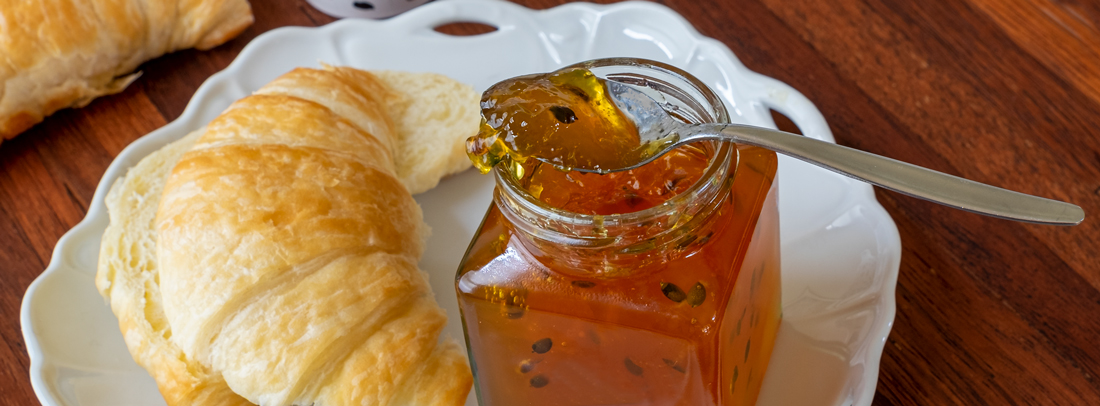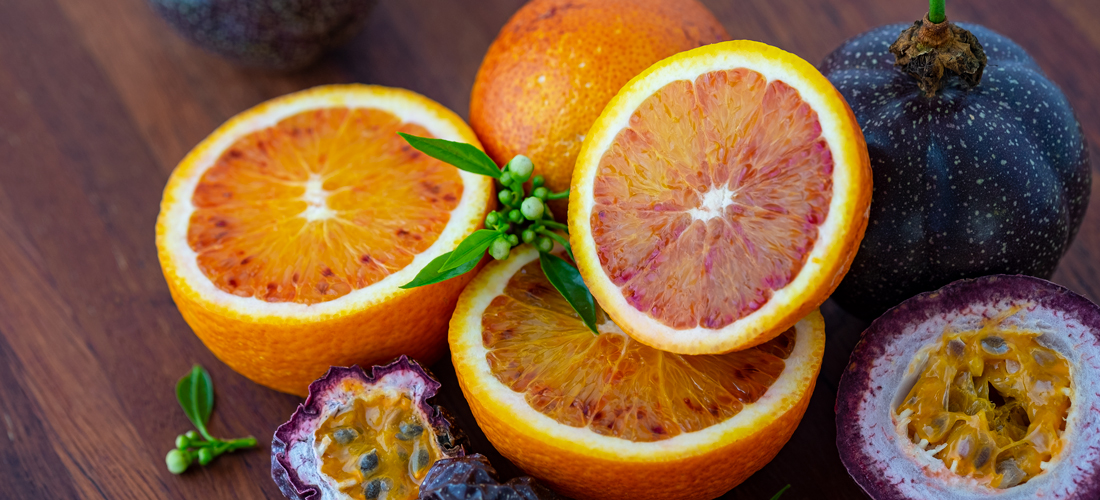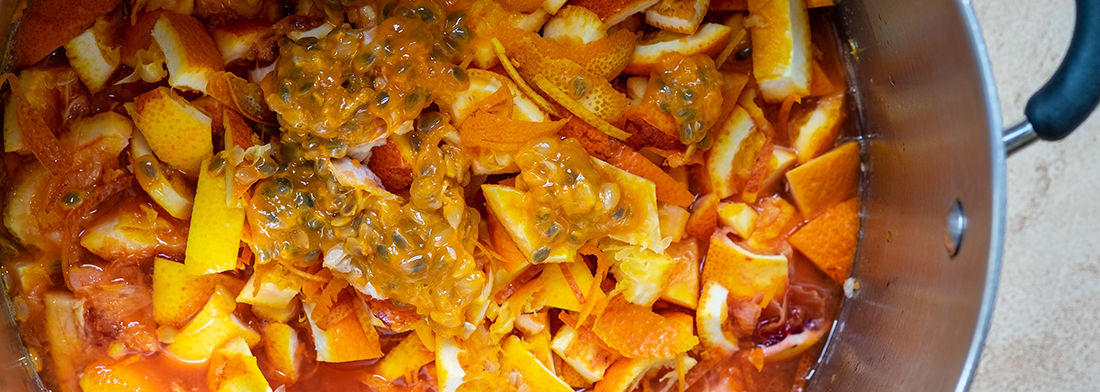Passionfruit & Orange Jelly Marmalade
- Jams, Jellies & Marmalades

Passionfruit’s sharp tropical citrusy flavour teams up with the orange aromatics to create a delightful full-flavoured spread. Some might call it a jam, others marmalade, call it what you will, but either way you’ll be looking for ways to spread it around. Use on your fave breakfast bread, English muffins, sourdough, croissant, or crumpets. Or jazz up your next cake, sponge, or Danish pastry with a liberal spoon in the filling or as part of the icing. Passionfruit curd, placed in individual pastry shells, topped with this marmalade is sooooo wickedly delicious. Two blissful mouthfuls.
Enjoyable anytime of the day, make the most of spring’s abundant harvest of this glorious Passiflora vine fruit and the robust flavour of blood orange. The tango of fine peel shred and passionfruit pips suspended in the sunset orange jelly is irresistible. Enjoy a spoon or two today.
- Preparation Time:
- 30 minutes plus overnight straining
- Cooking Time:
- 30 minutes
- Quantity:
- 5 x 200 ml jars
PREPARATION
Warm dry sterilised sealable glass jars and lids.
Warm sugar

INGREDIENTS
- 1 kg
- Blood orange, approx 5
- 14
- Passionfruit, medium
- 2
- Lemons
- 1.75 litres
- Water
- 400g per 500ml juice
- Sugar, white

METHOD
This jelly style marmalade is made by cooking the citrus and some passionfruit in water, then straining it to obtain the juice. This is then boiled with sugar, some shredded peel, and additional passionfruit seeds until set. It does not contain pieces of citrus fruit like a traditional marmalade.
Wash the blood oranges and lemons to remove any garden debris or wax if they have been commercially grown.
Using a vegetable peeler, remove the peel from 3 oranges. Place the peel, skin side down on a chopping board and cut peel into thin strips and put aside. This will become the peel shreds in the marmalade.
Juice the oranges and lemons and put the pips and lemon juice aside.
Cut the passionfruit in half and scoop out the pulp. Place the pulp from 10 passionfruit into the pan. Put the remaining pulp aside.
Roughly chop the orange and lemon shells and place in a large heavy bottom preserving pan with the orange juice, the reserved pips, passionfruit pulp (10) and water.
Bring to the boil, then simmer with the lid on until the citrus skins are soft. This stage extracts the orange and passionfruit flavour and the pectin from the citrus shells and pips.
Pour into a jelly bag and allow to drain naturally, preferably overnight or alternatively for a minimum of 4 hours. Refer to the Notes section below: How to Make a Jelly Bag. Measure the strained liquid and discard the cooked citrus shells.
Place the strained liquid into the preserving pan, add the remaining reserved passionfruit pulp, lemon juice and blood orange peel shreds. Bring to the boil and simmer gently, without the lid, until the peel is soft. Refer to the Notes section below: Peel Test.
To calculate the amount of sugar required allow 400g sugar for each 500 ml juice. Warm the required amount of sugar in the oven. Refer the Notes section below: How to Warm the Sugar.
Add a third of the warmed sugar to the pan and stir to quickly dissolve. Repeat the process 2 more times until all the sugar is dissolved. Bring back to boil and boil rapidly until the setting point is reached. If not, continue to boil and keep checking every 2 minutes until it reaches the set point using either the flake or wrinkle test or until it reaches 105 C/220 F.
-
Remove from the heat and place on a heat resistant surface. With a stainless-steel spoon or any spoon that has a relatively fine edge, skim the top of the marmalade to remove any scum that has accumulated during the cooking. Refer the Notes section below: Removing the Scum for more information if required.
Allow to cool slightly for 5-10 minutes, then stir gently to distribute the peel and passionfruit pips evenly.
Using a funnel, pour into warm dry sterilised screw cap sealable bottles and fill to approximately 2.5cm (1 inch) from the top of the jar. Seal while the marmalade is hot.
-
Label and store in a cool dark place in the kitchen or pantry.
Allow the marmalade to mature for at least 2 weeks before enjoying.
NOTES
- Use fresh citrus and passionfruit that have been recently picked as the pectin content is likely to be higher. Pectin is concentrated in the seeds, pith, and cores of the fruit. Don’t discard them, as they are invaluable in making jam, jellies and marmalade as it is the ratio between the fruit acids, pectin and sugar that makes them set.
- To wash the fruit, I use a pair of Skrub’a vegetable gloves. A wonderful invention made of a slightly course material that magically scrubs fruit and vegetables with the greatest of ease. Easy to wash and dry –they are an indispensable item in my kitchen. Special thanks to my very dear friend Sue who found them in a cookware shop. Alternatively use a kitchen vegetable brush.
- How to Make a Jelly Bag.
- A jelly bag is essential to make sweet and savory jellies. It can be made from heavy-duty calico, cotton flannel or close-weave nylon, multiple layers of muslin (cheesecloth) or any other material that will only allow the fruit juice to flow through. They are also commercially available through good homeware and specialty preserving stores.
- Secure the jelly bag tightly, using loops or very strong tape, on a stand, upturned stool or chair, in a jelly bag holder or over a stainless-steel sieve. Place a bowl underneath to catch the juice as it strains.
- Fill the jelly bag progressively with the cooked fruit mixture and all the cooking liquid. Leave to drain overnight.
- Do not squeeze the bag to extract the juice as this will create a cloudy jelly.
- Immediately after use, remove the pulp and seeds, thoroughly wash the jelly bag, and rinse several times. Completely dry the bag before storing. The bag can be reused multiple times, however, sterilise it before every use by scalding it with boiling water. This will also help to remove any residual traces of detergent and allows the juice to run freely through the bag, instead of being absorbed into it.
- Jelly yield is lower than jam as the pulp is discarded. The final yield will depend upon how juicy the fruit is, and this is influenced by the fruit’s ripeness and time of year.
- How to Warm Sugar.
- Put the recipe quantity in an oven proof container and place in a preheated 120 degrees C oven for approximately 10 minutes. The sugar should be warm to touch, not hot. Warmed sugar, dissolves quickly, and a rapid boil until the setting point is reached, helps to preserve the fresh citrus flavour.
- If you don’t have a preserving pan, use a large heavy bottom pot, preferably stainless steel. Ensure there is enough space available in the pot for the mixture to double in size while it is rapidly boiling.
- Peel Test
- To test if the peel is cooked, squeeze a piece of peel between the thumb and finger; it should squeeze easily to a mush.
- Removing the Scum
- Jams, jellies, and marmalades can produce a scum while they are boiling. Impurities from the fruit and sugar will rise to the surface and a fine frothy foam will move towards the edge of the preserving pan. Some fruits will produce more scum than others.
- This is a natural self-clarification process and makes the task of making a high-quality preserve easier. Removing the scum increases the preserve’s clarity. This is very important if it is being submitted for competition. Remove the scum before bottling. Using a stainless-steel spoon, skim the scum from around the edge of the preserving pan.
- Be careful to remove just the scum and not the jam. This can be done while the preserve is boiling and/or once it has been taken off the heat. Do not attempt to remove the scum from the centre of a boiling pan, as there is a high risk it will splutter and hot preserve burns!
- All cooking times are an approximation only.

Happy marmalading
